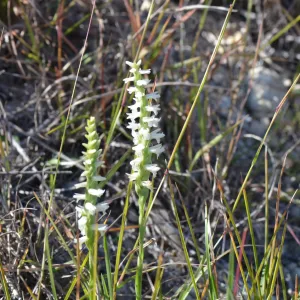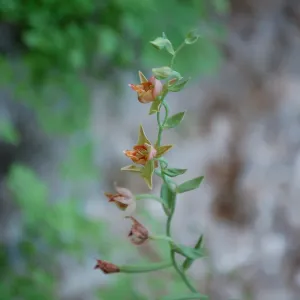By Delmar Cain
by Delmar Cain – Boerne Chapter, Native Plant Society of Texas
Published in the Boerne Star on November 22, 2013
Hill Country Orchids! Does that sound like an all girl western band from the 1990’s or a high school dance team? Of all the groups that it could be, who would have imagined that it might refer to flowers that are native to the Hill Country? One goes to the island of Borneo to find orchids growing in the wild, not to Boerne. Surprise!
My good friend, Wilt Shaw, recently sent me photographs of a native orchid that he photographed in the Hill Country. Craig Hensley, a Texas Parks and Wildlife Department Park Ranger at the Guadalupe River State Park, found it growing along the road to the park. Craig, a big hit with all the young park visitors, also has a good eye for butterflies, dragonflies, caterpillars and all types of water creatures. Now we can add plants to the list.
Even though Wilt told me that the orchid had a very pleasant fragrance, I assumed that it was the Nodding lady’s tresses (Spiranthes cernua), which is discussed in Marshall Enquist’s book, Wildflowers of the Texas Hill Country. But, I didn’t hesitate to go with Wilt to the site when he opted for a second visit to take more photographs. Even after seeing it, I was sure that the orchid was the species mentioned by Enquist. But, Wilt opted to send his photographs to Joe Liggio, one of the authors of Wild Orchids of Texas.
You have probably deduced by now that the species was not the Nodding lady’s tresses (Spiranthes cernua). Joe Liggio opined that the orchid was probably the Great Plains lady’s tresses (Spiranthes magnicamphorum), given that “they were growing on calcareous limestone soil.” Also the size and the fact that it was fragrant added additional weight to its identity. Still the only sure way to tell the difference is a microscopic examination of the chromosomes.
From its base this orchid produces an erect stem that is 6 to 15 inches tall. The white flowers are produced in spirals along the upper 2-4 inches of the stem. The flower is easily missed in tall KR bluestem. But when it is spotted and examined, like many members of its family, Orchidaceae, it is quite stunning in appearance.

Amazingly to me, this perennial orchid is found growing natively from Texas east to Georgia and north through the Central United States into Canada. It is also found in two counties in northern New Mexico. Its bloom period, which extends from September to December, indicates that it is cold hardy. We should also take the advice that Enquist gave about Spiranthes cernua, which is that “[T]hese small beauties should be admired in place, as they are next to impossible to transplant.”

In July of 2010 I received pictures of another species of Hill Country orchid from another friend, Bill Ward. Bill had many contacts and one of them had spotted the orchid and told him of its location. Bill and his wife, Kathy, were always ready to view and photograph another plant, especially a unique plant such as the Glass Mountain crested coralroot (Hexalectris nitida).
In our area this species is found in old juniper and oak forests. It emerges through the leaf litter on the ground and blooms between June and August. It may have as many as 20 small flowers on its single reddish or purplish stem, which is less than 12 inches tall. The same orchid expert, Joe Liggio, advised Bill that the flowers of this orchid self-pollinate and do not always open. The coral flowers in Bill’s pictures were not open.
This perennial orchid may not bloom every year and it is not widely distributed. It is found in 17 counties in Texas, two counties in New Mexico and in Mexico. It is endangered in New Mexico.
A third Hill Country orchid, the chatterbox orchid (Epipactis gigantea), was pointed out to me on a nature walk along the creek at the Cibolo Nature Center. It was growing at the base of a large cypress tree at the edge of the water. I don’t know who showed it to me but I do remember thinking that I had seen that same plant along Spring Creek, which runs through our own property. That was another pleasant surprise.

This species of orchid, also commonly called the Giant Hellebore or stream orchid, is usually found along streams or in bogs or wet areas near streams. Its stems can grow up to 3 feet in length. It also has lance shaped leaves that may be five inches in length along the stems. The flower of the chatterbox orchid does open and gives it one of its common names. The lower lip of the flower moves as if hinged when the flower is touched or blown.
On a prostrate stem the flowers hang from the stem and may be an inch across. The flowers are green and brown with lines of rust or red in the interior. This perennial blooms from April to July.
We are near the eastern edge of the range of the giant hellebore. It grows natively in all of the states west of Texas and into British Columbia. It also can be found in Mexico.
These four species of Hill Country orchids remind me once again of the diversity and the beauty of our region. To view a small piece of that beauty for yourself, check the ten Great Plains lady’s tresses blooming on the west side of Mueller Street, just south of the St Peter’s Catholic Church on Kronkosky Street in Boerne.


